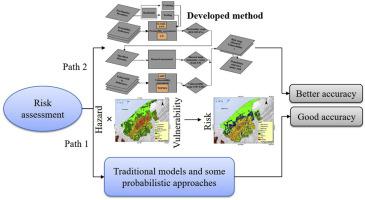International Journal of Disaster Risk Reduction ( IF 4.2 ) Pub Date : 2020-07-06 , DOI: 10.1016/j.ijdrr.2020.101723 Ratiranjan Jena , Biswajeet Pradhan

|
The current study presents a novel combination of artificial neural network cross-validation (fourfold ANN-CV) with a hybrid analytic hierarchy process-Technique for Order of Preference by Similarity to Ideal Solution (AHP-TOPSIS) method to improve the earthquake risk assessment (ERA) and applied it to Aceh, Indonesia, to test the model. Recent studies have suggested that neural networks improve probability mapping in a city scale. The network architecture design with probability index remains unexplored in earthquake-based probability studies. This study explored and specified the major indicators needed to improve the predictive accuracy in probability mapping. First, probability mapping was conducted and used for hazard assessment in the next step. Second, a vulnerability map was created based on social and structural factors. Finally, hazard and vulnerability indices were multiplied to produce the ERA, and the population and areas under risk were calculated. Results show that the proposed model achieves 85.4% accuracy, and its consistency ratio is 0.06. Risk varies from very high to high in the city center, approximately covering an area of 23% (14.82 km2) and a total population of 54,695. The model's performance changes on the basis of the input parameters, indicating the selection and importance of input layers on network architecture selection. The proposed model is found to generalize better results than traditional and some existing probabilistic models. The proposed model is simple and transferable to other regions by localizing the input parameters that contribute to earthquake risk mitigation and prevention planning.
中文翻译:

集成的ANN交叉验证和AHP-TOPSIS模型可改善地震风险评估
当前的研究提出了一种新的方法,将人工神经网络交叉验证(四重ANN-CV)与混合层次分析法相结合-通过类似于理想解决方案的优先顺序技术(AHP-TOPSIS)方法来改善地震风险评估( ERA)并将其应用于印度尼西亚亚齐(Aceh),以测试该模型。最近的研究表明,神经网络可以改善城市范围内的概率图。在基于地震的概率研究中,尚未开发具有概率指数的网络体系结构设计。这项研究探索并指定了提高概率图预测准确性所需的主要指标。首先,进行概率映射并将其用于下一步风险评估。其次,根据社会和结构因素创建了漏洞图。最后,将危害和脆弱性指数相乘以得出ERA,并计算出人口和受威胁的区域。结果表明,所提模型达到了85.4%的精度,一致性率为0.06。市中心的风险从高到高不等,大约占23%(14.82 km2),总人口为54,695。该模型的性能根据输入参数而变化,这表明输入层的选择和对网络体系结构选择的重要性。发现提出的模型比传统的和一些现有的概率模型能更好地推广结果。通过定位有助于减轻地震风险和预防计划的输入参数,提出的模型很简单,并且可以转移到其他地区。










































 京公网安备 11010802027423号
京公网安备 11010802027423号